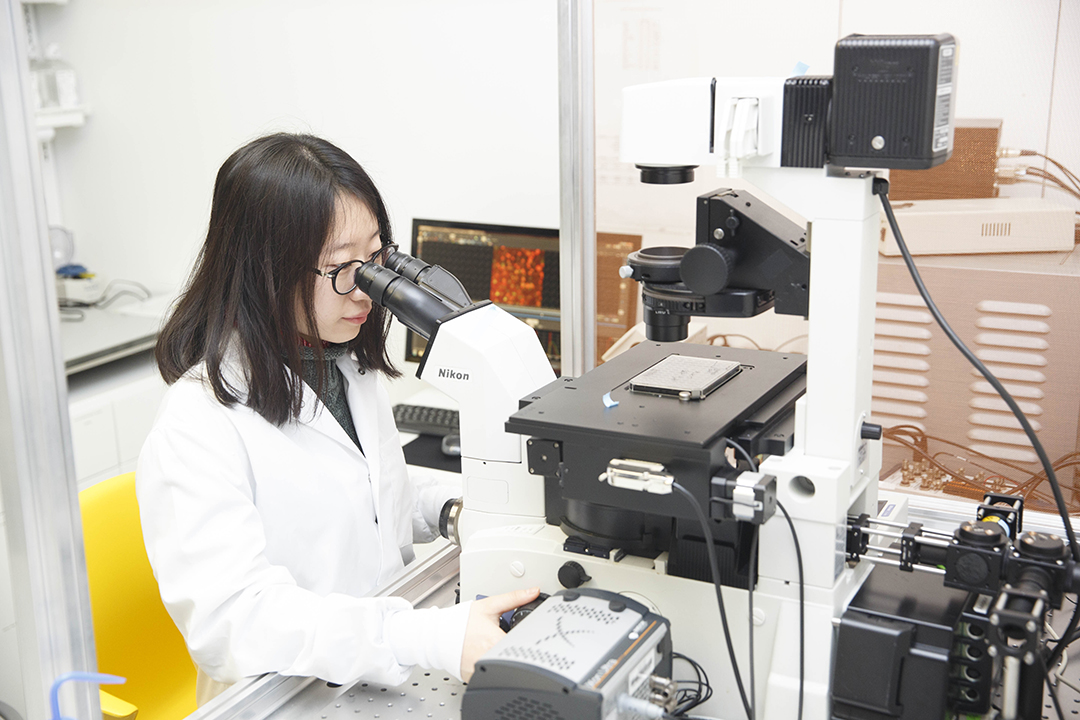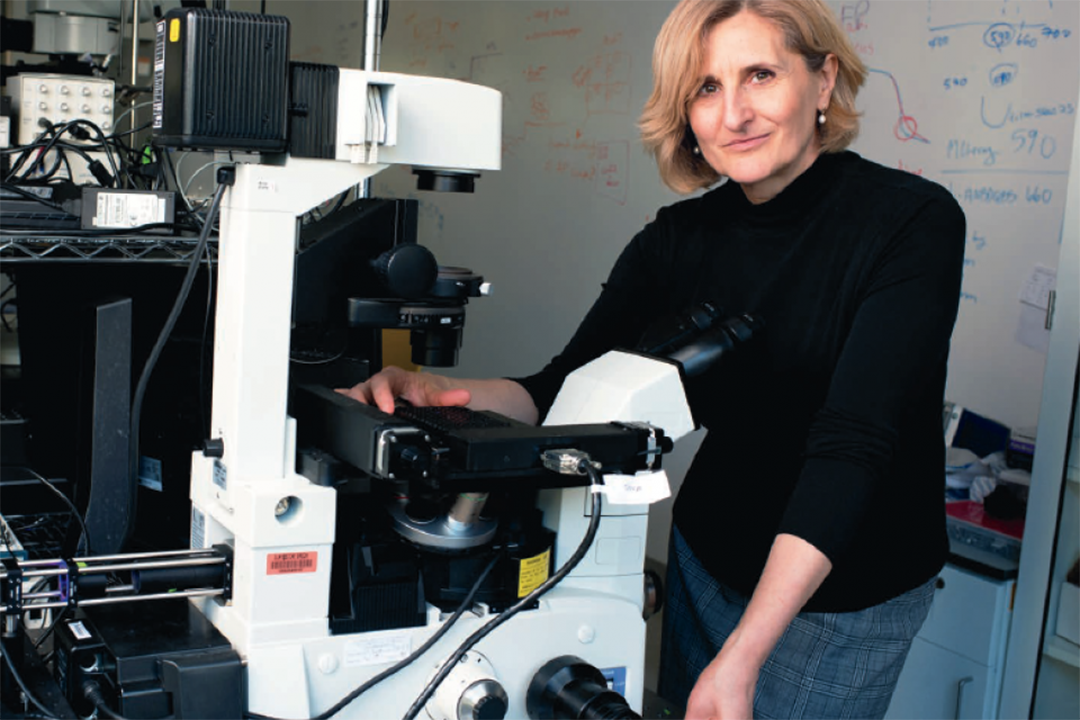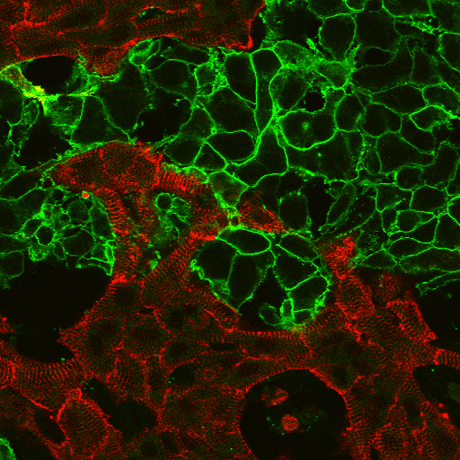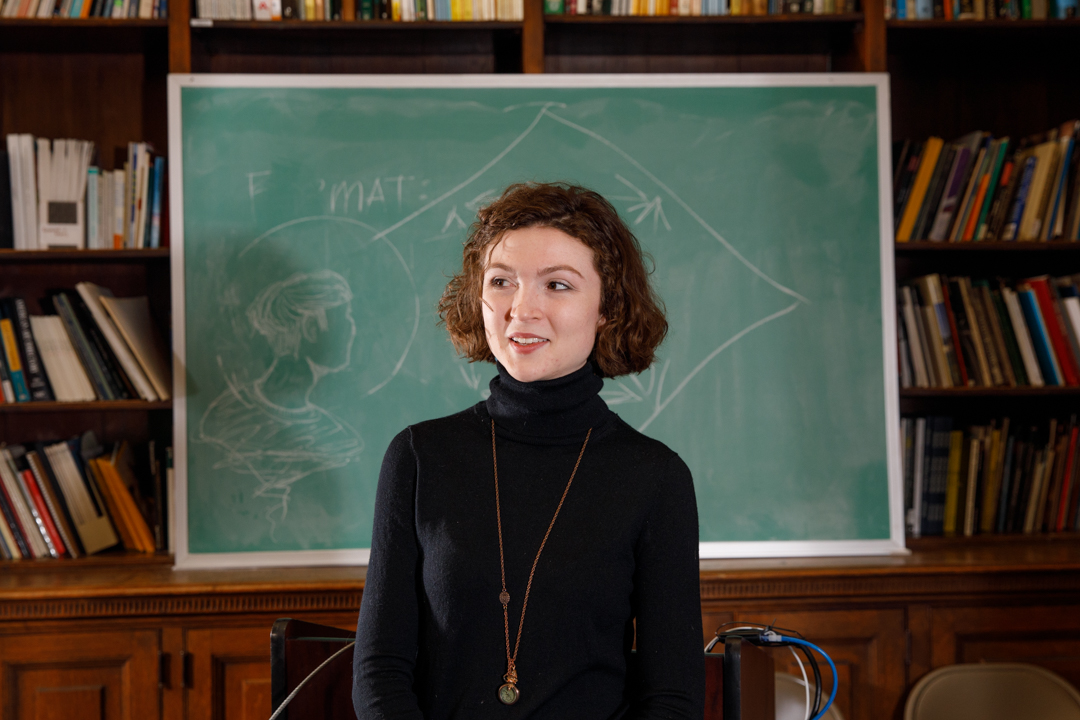By Kristen Mitchell
Emilia Entcheva, a professor and a leader in cardiac optogenetics is shaping the future of personalized medicine from her School of Engineering and Applied Science lab. With more than $7 million in federal funding and several ongoing projects, she and her research team and collaborators are developing better ways to use light to grow engineered human heart tissue.
Dr. Entcheva is at the forefront of cardiac optogenetics, a biological technique that uses light to control cells in living tissue, in this case the heart, that have been genetically modified to express light-sensitive ion channels. She works closely with nine undergraduate and graduate students who contribute to these projects.
Optogenetics involves the use of light-sensitive proteins that normally are not found in the human body; they typically come from lower organisms like algae or bacteria. Those proteins are extracted and then introduced to human heart cells in order to make them respond to light and to be able to control them by light.
When combined with optics, these light-responsive cells and tissue are used to interrogate and understand biological processes, such as cardiac arrhythmias. Dr. Entcheva’s lab recently has been focused on induced stem-cell derived heart cells. The cells can be obtained in a minimally invasive way from the blood or skin of a patient and reprogrammed to become heart cells. The technique offers new possibilities to grow patient-specific hearts in a dish, can answer fundamental questions about the human heart and will contribute to health care innovation and personalized screening, she said.
Over the past six months, Dr. Entcheva has been named a lead researcher on four federally-funded projects. Most recently, Dr. Entcheva and Matthew Kay, a biomedical engineering professor, were awarded $2.8 million by the National Institutes of Health (NIH) to lead a four-year project to develop interdisciplinary technology that will help improve the maturity of human heart cells for use in drug screening and other applications.
This grant seeks to address criticism that induced stem-cell derived cardiomyocytes, cardiac muscle cells, created from blood samples are not mature enough to fully replicate how the human heart would react to a certain drug, rendering them an imperfect option for testing.
“Our approach to maturation in this project is to provide chronic stimulation by light while the cells grow so that they experience the heartbeat throughout and at the same time to also ensure that they are getting the right amount of oxygen,” she said.
Dr. Kay is producing a nanocarrier blood substitute for the research that will help the team simulate real-world cell development. Together with several other GW researchers, they will design a sophisticated system to monitor and assess different parameters to help researchers achieve optimal cell performance. They will create thousands of samples and generate a vast dataset of previously unavailable information that will help them better understand how induced stem-cell derived cardiomyocytes control their metabolism.
“It is important to have confidence that we have well-behaved cells in order to consider putting them in the human body,” Dr. Entcheva said.
In the future, these well-behaved cells could be used to improve outcomes for patients considering high-risk therapies and promote cell regeneration.
Michael Degaga (left), Weizhen Li, Sarah Schrup, Emilia Entcheva, Christianne Chua and Julie Han attended the 2018 BMES Annual Meeting in Atlanta. (Photo provided by Dr. Entcheva)
Transforming basic science
From her lab on the ground floor of Science and Engineering Hall, Dr. Entcheva tackles the challenges of scientific advancements today with an eye toward treatments of tomorrow.
In August, Dr. Entcheva was awarded a competitive $2 million Emerging Frontiers in Research and Innovation (EFRI) grant by the National Science Foundation (NSF) for a four-year collaboration among SEAS, GW Cancer Center, Harvard and Georgia Tech. Her lab will work to gain a better understanding of how DNA packing and transcription in the heart cells can be controlled by light to inspire new therapies at the intersection of oncology and cardiology. Many of the novel optogenetic tools her lab works with have the potential to empower fundamental research outside of cardiology and are therefore ripe for interdisciplinary collaboration. It’s hard to say how one small manipulation will contribute to the mosaic of basic science, she said.
This highly competitive EFRI grant is a sign that NSF sees GW as an institution with scientific advancements worthy of significant investment, Dr. Entcheva said.
The collaborative nature of this work is stimulating for Dr. Entcheva. Often the concepts applied across fields are relatively simple, but they can be revolutionary when applied to a new domain. Drawing on their diverse backgrounds, researchers can make advancements that optimize impact, she said. Zhenyu Li, an associate professor of biomedical engineering and microfluidics expert, is part of the team on both projects.
“Sometimes it doesn’t involve rocket science,” she said. “The optics that we use is not very complex, but you have to have a broader vision to merge sometimes unexpected components from biology and engineering.”
Dr. Entcheva’s work has implications for getting potentially life-saving drugs to the market faster. Earlier this year she received an NSF grant to develop a stand-alone prototype of the system in her lab that can test how a particular drug will impact the heart, as required by the Food and Drug Administration. A prototype can create opportunities to commercialize the technology.
“The FDA requires that drugs be screened for cardiotoxicity, even if it’s cough medicine,” she said. “That kind of test is essential for drug development, and we have developed a new generation of tools to do that using optics and optogenetic techniques.”
More knowledge, better treatment
While Dr. Entcheva juggles a number of specific projects and grants, one overarching goal drives her work: She wants to improve personalized medicine by improving stem-cell technology.
If someone is about to undergo chemotherapy for an advanced form of cancer, there is a strong genetic component to determining what type of therapy would benefit a patient the most while minimizing negative side effects, such as damage to the heart, Dr. Entcheva said.
For example, one class of treatment for breast cancer, doxorubicin, can be extremely toxic to the heart. Some patients who undergo this treatment have severe reactions and develop fatal heart failure. With a sample of the patient’s cells and technology improvements, however, researchers could steer high-risk individuals to alternative therapies.
At the moment it takes several months to turn blood into stem cells—too long when considering immediate treatment options. Dr. Entcheva envisions a world where, someday, everyone would have their blood drawn, transformed genetically to create stem cells and stored in biobanks.
These cells could be frozen and stored for decades, when they would be available for a quick study if the patient develops a life-threatening disease later in life. Researchers could then transform the stored stem cells into cardiac muscle cells in just a few weeks. Biobanks exist today, but Dr. Entcheva hopes that in the future they become a mainstream component of health care.
“In many cases there are gene mutations that you otherwise wouldn’t know you have unless you do genetic testing and unless there are symptoms, and in many cases there are no symptoms,” she said. “If there is a clinical question that needs to be answered, we can uncover that in a dish. If a drug is likely to cause severe cardiotoxicity, we will know.”

Weizhen Li, a first-year doctoral student, works in Dr. Entcheva's Science and Engineering Hall lab. (Logan Werlinger/ GW Today)
Empowering tomorrow’s experts
Dr. Entcheva’s many projects allow her to work closely with undergraduate and graduate students in her lab. Through this mentorship, she is inspiring the next generation of optogenetics researchers.
Sarah Schrup, a senior studying biophysics, is combining her passion of physics and biology in Dr. Entcheva’s lab. She has spearheaded the lab’s collaboration with the GW Cancer Center, with Alejandro Villagra’s lab, where she is currently testing a therapeutic agent that can be manipulated by light and is developing a drug screening model for cancer therapy using optical techniques.
Research has helped Ms. Schrup explore new ways to combine her interests in medicine and biomedical engineering and has given her the confidence to take the lead on complicated projects. Last year she was awarded the Undergraduate Research Award to pursue her own research. In the spring she studied abroad in London, where she worked with one of Dr. Entcheva’s collaborators. Last year Ms. Schrup won the Barry Goldwater scholarship, the most prestigious national-level recognition for U.S. undergraduate students in STEM, for her research in Dr. Entcheva’s lab.
“It’s sort of brought something beyond my academic experiences, brought real-world applications of what I’m learning into my curriculum,” she said. “I really do see it as part of my educational curriculum.”
Christianne Chua, a sophomore in biomedical engineering, wasn’t sure what to expect when she started working in the lab last summer. She had never heard of optogenetics before meeting Dr. Entcheva. But Ms. Chua quickly was integrated into the research world. She began working on existing projects and even learned how to develop experiment protocols of her own and has already presented her research at a national professional meeting.
When she first came to GW, she pictured herself working in industry after graduation. After working under Dr. Entcheva, however, she is hoping to continue research.
“Seeing what we learn in the classroom being applied right in front of our eyes is really cool,” she said.
Michael Degaga, a sophomore studying biomedical engineering and Trachtenberg scholarship recipient, started training to be a research assistant in the lab at the end of his first year at GW. He likes working in Dr. Entcheva’s lab because undergraduate students have the same opportunities to learn and grow their skills and be independent as Ph.D. candidates.
“Everyone gets to do the stuff the others do. If there is a high-level training happening, she would want every student to go, not just graduate students or Ph.D. candidates,” he said. “I’ve realized just from joining it freshmen year, I have learned so much, and there is still so much to learn over the next few years.”




